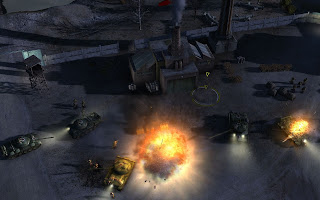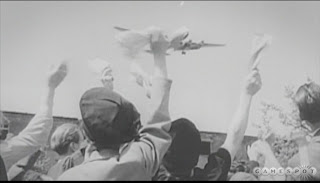The latest addition to the Codename Panzers lineup is too straightforward and simplistic.
Review By Kael
While Germany's estimable Panzer tanks may have gone the way of the dodo at the end of World War II, that little fact doesn't seem to matter much to InnoGlow (formerly Stormregion). The developer has pushed history under the bus with Codename Panzers: Cold War, the third release in the series of real-time strategy games and the first to take the franchise beyond the war that gave us the A-bomb and the Andrews Sisters. But an offbeat name is the least of the problems that gamers have to deal with here. Formulaic design and tactical limitations make the game a mostly frustrating experience, even if you couldn't care less about the historical accuracy of the game's title.
Veterans of either of the two previous Codename Panzers games won't find many surprises here, as the game is a straight-up rehash of the 2002 and 2004 predecessors. The only differences are in the storyline, which has been moved forward a few years. Instead of once more refighting the Second World War on those oh-so-familiar battlefields, you now scrap it up through an alternate-history Cold War. In this reality, the Soviet blockade of Berlin in 1949 turns into a hot war.
Sooner than you can say do svidaniya to the uneasy peace that has held since 1945, Soviet troops and tanks are rolling into West Germany, and World War III is under way. The four-chapter solo campaign features slices of this conflict from across central Europe. You first guide Yank NATO troops under Lt. Douglas Kirkland and then take charge of forces under the command of German WWII veteran Hans Von Groebel. Two- to eight-man multiplayer is also offered via GameSpy online and LAN, with game modes such as team deathmatch and domination.
Gameplay also sticks close to the franchise essentials. Battles remain fairly small-scale, especially in comparison to a typical RTS game, where dozens if not hundreds of units face off in battles. Here, you generally control no more than a handful of tanks, companies of soldiers, and APCs at a time, along with a few special locations, such as helicopter pads where you order reinforcements and medical tents that can mass-heal troops. This keeps things simple, making the game ideal for a beginner RTS gamer or an old hand who likes to play something straightforward every now and then. Difficulty levels support this, too.
Easy is actually easy, to the point where you can breeze through missions without losing more than one or two units, while hard and ultra are murderously challenging. This is a welcome change from many other WWII-era RTS games, which seem to delight in punishing gamers with insane difficulty even on the easiest settings.
But it all plays out way too formulaically. Campaign missions offer cliched WWII RTS objectives, such as protecting allied convoys, destroying bases, defending locations for set periods of time, and so forth. Settings also include a lot of old standards, such as rustic villages, railway yards, and rainy forests. Unit selection is limited. You generally have just a few choices to make when loading up for a mission.
Mostly, you get only the basics. So your choices are limited to troops like SMG squads, bazooka teams, and mine-clearing engineers, and a few types of tanks with various weaponry and armor. Units can be tricked out with tweaks like AA guns and flamethrowers, although there isn't much in the way of customization. There is little room to experiment with unit deployment, anyway. Most levels involve direct assaults up roads or pathways. Every time you need to use a particular unit's special ability, it's glaringly obvious what you need to do. If, for example, you receive an emergency airdrop of engineers, you know right away that there must be a minefield nearby that they need to sweep.
Lack of choice keeps everything straight and to the point, although this also means that you start experiencing deja vu after just a few scenarios due to all the repetition. All you really have to learn is the importance of healing and repairing. If you back up frontline assault troops with a squad of medics, you have instant healing on demand during battles. If you send out an APC or two with every tank column, you can repair damage dealt to your armor on the fly. There are limits to how much can be fixed up, of course, but the repairing/healing range is so extreme that you can situate medics and APCs well behind the fray and still provide loads of support to the poor suckers taking direct fire.
This almost gives the game a sci-fi vibe, because it seems absurd that assistance can be rendered from such a long way off in battles taking place during the late 1940s and early 1950s. Healing and repairing appear to be immediately transported to units in need, courtesy of crosses and metal plates that fly through the air between units. It looks like they're beaming the help over, which doesn't give the game much of a WWII or Cold War feel.
Lack of choice keeps everything straight and to the point, although this also means that you start experiencing deja vu after just a few scenarios due to all the repetition. All you really have to learn is the importance of healing and repairing. If you back up frontline assault troops with a squad of medics, you have instant healing on demand during battles. If you send out an APC or two with every tank column, you can repair damage dealt to your armor on the fly.
There are limits to how much can be fixed up, of course, but the repairing/healing range is so extreme that you can situate medics and APCs well behind the fray and still provide loads of support to the poor suckers taking direct fire. This almost gives the game a sci-fi vibe, because it seems absurd that assistance can be rendered from such a long way off in battles taking place during the late 1940s and early 1950s. Healing and repairing appear to be immediately transported to units in need, courtesy of crosses and metal plates that fly through the air between units. It looks like they're beaming the help over, which doesn't give the game much of a WWII or Cold War feel.
Lack of choice keeps everything straight and to the point, although this also means that you start experiencing deja vu after just a few scenarios due to all the repetition. All you really have to learn is the importance of healing and repairing. If you back up frontline assault troops with a squad of medics, you have instant healing on demand during battles. If you send out an APC or two with every tank column, you can repair damage dealt to your armor on the fly.
There are limits to how much can be fixed up, of course, but the repairing/healing range is so extreme that you can situate medics and APCs well behind the fray and still provide loads of support to the poor suckers taking direct fire. This almost gives the game a sci-fi vibe, because it seems absurd that assistance can be rendered from such a long way off in battles taking place during the late 1940s and early 1950s.
Healing and repairing appear to be immediately transported to units in need, courtesy of crosses and metal plates that fly through the air between units. It looks like they're beaming the help over, which doesn't give the game much of a WWII or Cold War feel.
NAME: CODENAME PANZERS - COLD WAR
SYSTEM: PC 














No comments:
Post a Comment